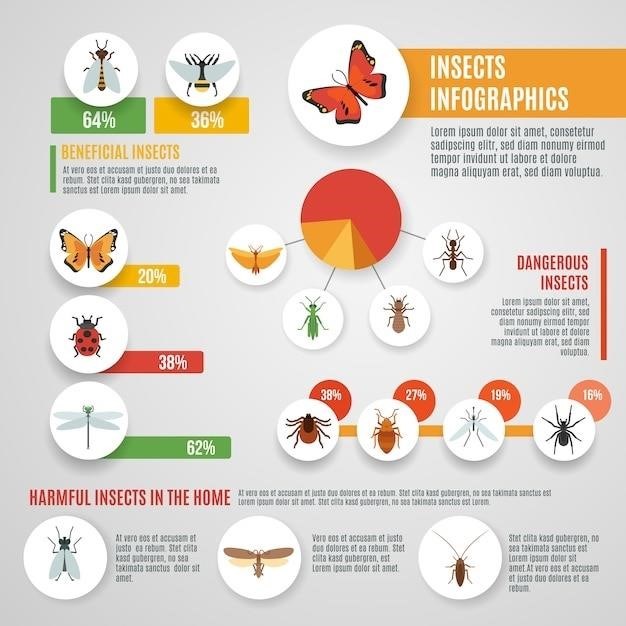Insect Eggs Identification Guide⁚ USA
Identifying insect eggs can be a valuable skill for gardeners, farmers, and anyone interested in the natural world; This guide will provide information on how to identify insect eggs in the USA, covering their appearance, location, and specific examples.
Introduction
Insect eggs are a fascinating and often overlooked part of the insect life cycle. Understanding how to identify them can be crucial for managing pests in gardens, farms, and even homes. Identifying insect eggs involves recognizing their unique characteristics, such as their color, shape, size, arrangement, and texture. This guide will equip you with the knowledge to identify common insect eggs found in the USA, helping you to better understand the insect world around you.

Common Insect Eggs Found in the USA
The USA is home to a diverse array of insects, each with its own unique egg-laying habits. Some of the most common insect eggs you might encounter include those of whiteflies, grasshoppers, cutworms, aphids, and spider mites. These insects are prevalent in gardens, fields, and even homes, and understanding their egg characteristics can help you identify and manage potential infestations.
Identifying Insect Eggs by Appearance
Insect eggs come in a variety of shapes, sizes, colors, and textures, making visual identification a key aspect of recognizing them. Paying close attention to these features can help you distinguish between different types of eggs. For instance, some eggs are smooth and globular, while others are rough and ridged. Color also plays a role, with some eggs being transparent, others opaque, and some even exhibiting a range of colors.
Color
The color of insect eggs can vary greatly, ranging from white to black, and even incorporating shades of yellow, brown, green, and red. Some eggs, like those of whiteflies, are a stark white, while others, such as those of stink bugs, are a darker brown or black. The color can often be a clue to the type of insect that laid the eggs, so it’s important to note this characteristic when attempting identification.
Shape
Insect eggs come in a variety of shapes, which can be helpful in identification. Some are round or oval, like those of grasshoppers, while others are elongated or cylindrical, resembling tiny capsules. There are also irregularly shaped eggs, such as those of some beetles, which can be difficult to categorize. The shape, combined with other characteristics like color and arrangement, can help you narrow down the possibilities and identify the insect responsible for the eggs.
Size
The size of insect eggs can vary greatly, from microscopic to visible to the naked eye. Some eggs are barely larger than a grain of sand, such as those of wasps, while others can be as large as a peanut, like the eggs of the Malaysian stick insect. The size of the egg can be a helpful indicator of the type of insect, although it’s not always conclusive. For example, while mosquito eggs are about 1 millimeter long, the eggs of some species of beetles can be much larger.
Arrangement
The way insect eggs are arranged can also be a helpful identification tool. Some insects lay their eggs in clusters, while others lay them individually. For example, whiteflies lay their eggs in concentric patterns on the undersides of leaves, while grasshoppers lay their eggs in pods buried in the soil. The arrangement of eggs can also vary depending on the species of insect. For instance, some species of moths lay their eggs in rows, while others lay them in a random pattern.
Texture
The texture of insect eggs can also be a helpful identification clue. Some eggs are smooth and glossy, while others are rough and bumpy. Some may be covered in a sticky substance that helps them adhere to surfaces, while others are covered in hairs or spines. The texture of eggs can vary depending on the species of insect and the environment in which they are laid. For example, some insects lay eggs in damp environments, and their eggs may have a more slimy texture.
Location of Insect Eggs
The location where insect eggs are found can be another key to identification. Some insects lay their eggs on the undersides of leaves, while others prefer to lay them on bark or tree trunks. Some insects may even lay their eggs in the soil. Knowing where to look for insect eggs can help you narrow down the possibilities and identify the specific insect species responsible. For instance, if you find small, white, oval-shaped pods buried in soil or attached to plants, they might be grasshopper eggs.
On Leaves
Many insect species lay their eggs on the undersides of leaves, where they are protected from the elements and predators. You can often find clusters of eggs, sometimes in distinct patterns, on the underside of leaves. Common examples include whiteflies, which lay their tiny, white eggs in concentric patterns, and aphids, which lay their eggs in rows or clusters.
On Bark and Tree Trunks
Tree-dwelling insects often lay their eggs in crevices or bark folds on branches and trunks. These locations offer protection from the elements and potential predators. Look for small, white or light beige oval-shaped pods, which are often laid together in clusters. Examples include insects like bark beetles, which lay eggs under the bark, and some moth species that lay their eggs in bark crevices.
In Soil
Many insects lay their eggs in the soil, either near the base of plants or in areas with good drainage. These eggs are often protected by a layer of soil or debris. Look for small, white or light beige oval-shaped pods, which are often laid together in clusters. Some common examples include grasshoppers, which lay their eggs in pods in the soil, and cutworms, which lay their eggs near the base of plants.
Identifying Specific Insect Eggs
Identifying insect eggs to the species level can be challenging, but there are some key features to look for. For example, whiteflies lay tiny white eggs in concentric patterns on the undersides of leaves. Grasshoppers lay their eggs in pods in the soil. Cutworms lay their eggs near the base of plants, and aphids lay their eggs on the stems and leaves of plants. Spider mites lay their eggs in clusters on the undersides of leaves, and they are often covered in a fine webbing.
Whiteflies
Whiteflies are tiny, sap-sucking insects that can cause significant damage to plants. Their eggs are small, oval-shaped, and white, and they are often laid in clusters on the undersides of leaves. The eggs are typically laid in concentric patterns, starting from the bottom of the leaf and moving towards the top. A single whitefly can lay up to 200 to 400 eggs, and they can hatch within two weeks, depending on the temperature.
Grasshoppers
Grasshopper eggs are usually found in the soil, near the base of plants. They are small, round, and have a smooth shell. They are often laid in clusters of 10-30 eggs, and they may hatch within two weeks, depending on the temperature. To confirm if you have found grasshopper eggs, gently dig one out and study its characteristics. The eggs are often white or light beige and are typically buried in soil or attached to plants.
Cutworms
Cutworm eggs are often found in the soil, near the base of plants, as they are laid in clusters of 10-30 eggs. The eggs themselves are very small, typically white or light beige, and are often oval-shaped. Cutworm eggs can be difficult to identify, but they are typically laid in clusters, making them easier to spot. If you suspect cutworm eggs, you can gently dig up the soil and check for small, white or beige pods.
Aphids
Aphids are tiny, soft-bodied insects that often lay their eggs on the undersides of leaves, particularly in clusters. The eggs are typically oval-shaped and can vary in color from white to black depending on the species. Aphid eggs are often covered in a waxy coating that helps to protect them from the elements. A single aphid can lay up to 350 eggs, which hatch within two weeks depending on the temperature. Identifying aphid eggs can help you to control infestations early on.
Spider Mites
Spider mites are tiny arachnids that can be a serious pest of plants. They lay small, round eggs that are often laid in clusters on the undersides of leaves. Spider mite eggs are typically white or cream-colored and can be difficult to see with the naked eye. They are often found in web-like structures that the mites spin to protect themselves. If you suspect a spider mite infestation, look for these tiny eggs on the leaves of your plants. Early detection and control are crucial to prevent significant damage to your plants.
Resources for Identifying Insect Eggs
Identifying insect eggs can be challenging, but various resources can help. Online databases like BugGuide.Net offer detailed information, images, and identification guides for North American insects. Field guides specifically dedicated to insect eggs can provide valuable visual references. If you need further assistance, consulting with a professional entomologist can provide expert identification and advice.
Online Databases
The internet offers a wealth of resources for identifying insect eggs. BugGuide.Net is a popular online database dedicated to North American insects, spiders, and their kin. This site features a vast library of images, identification guides, and information on various insect species, including their eggs. Other online resources may also offer specific information on insect eggs, including identification guides, images, and descriptions.
Field Guides
Field guides are invaluable tools for identifying insect eggs in the field. These guides often feature detailed descriptions, illustrations, and photographs of various insect eggs, along with information on their life cycle, habitat, and potential damage. Look for guides specifically focused on insects of your region or those covering a broad range of insect species.
Professional Entomologists
If you’re struggling to identify insect eggs or need expert advice on managing insect infestations, consider reaching out to a professional entomologist. These scientists specialize in the study of insects and can provide accurate identification, recommendations for control measures, and insights into the biology and ecology of the insect in question. Many universities, government agencies, and pest control companies have entomologists available for consultation.
Identifying insect eggs is a crucial step in understanding and managing insect populations, especially in gardens and agricultural settings. By learning to recognize common insect eggs based on their appearance, location, and associated insect species, you can take proactive measures to prevent infestations and protect your plants. Remember, if you’re unsure about the identification of insect eggs or need assistance with control, consulting a professional entomologist is always a wise choice.
